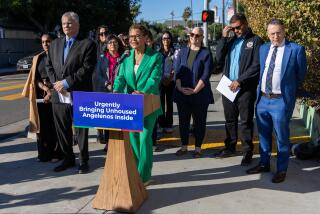Editorial: Venice homeless plan is smart and enterprising
The seaside community of Venice is home to one of the largest concentrations of homeless people in the city of Los Angeles. An estimated 1,000 people without housing camp on its streets and sidewalks, leading to clashes with residents, merchants and police. The L.A. City Council recently adopted a comprehensive strategy for tackling the problem, but it hasn’t found a way yet to raise the considerable amount of money needed to pay for it. Rather than waiting for that to happen, Councilman Mike Bonin has laid out a way to move forward a few productive steps at a time.
One part of Bonin’s plan is to repurpose the shuttered Westminister Senior Center, a sizable city-owned property in Venice, for much-needed storage space where homeless people could stash their belongings. Another would direct the city’s Department of Recreation and Parks to identify public restroom facilities near the beach that could be open 24 hours a day, instead of closing late at night and reopening early in the morning. And the most ambitious proposal calls for the city to lease a 177-space parking lot owned by the city’s Department of Transportation to a non-profit developer to build housing for homeless people while still providing parking spaces to the public. According to Bonin, the site could support up to 90 small units.
All of these proposals require the approval of the full council, and none by themselves would eradicate homelessness in Venice, let alone in the city of L.A., where 26,000 residents are homeless. The sites he’s suggested may also draw neighborhood opposition, an obstacle that stymied a number of previous efforts around the city. But Bonin’s proposals are just the sort of steps that need to be undertaken locally and championed by local elected officials. The city’s overall strategy calls for officials to identify potential sites for storage and housing, particularly on idle city-owned property. Using city property would dramatically cut the costs faced by the developers of the housing. And in this case, Bonin has identified property on the Westside, one of the most expensive areas of the city.
The mayor’s proposed 2016-2017 budget has also identified, with support from other council members, city-owned sites in several council districts that could be good locations for new housing for homeless people. Still, city officials have calculated that it could take almost $2 billion to build housing on the scale necessary to address homelessness in a sweeping manner. So until the city comes up with that revenue stream, council members will need to support local building projects across the city that can, more quickly and affordably, help stem one of the city’s most pressing crises.
Follow the Opinion section on Twitter @latimesopinion and Facebook
More to Read
A cure for the common opinion
Get thought-provoking perspectives with our weekly newsletter.
You may occasionally receive promotional content from the Los Angeles Times.






